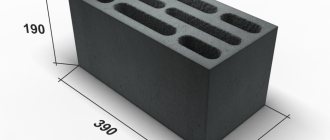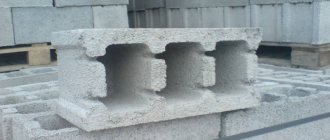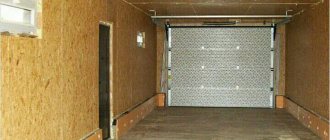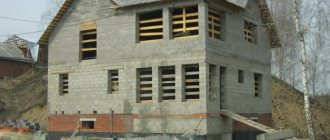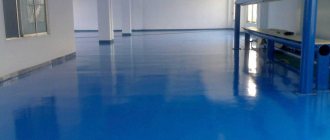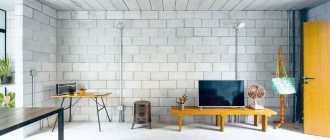The construction market offers many options for materials suitable for constructing the walls of a home. A house made of foam blocks is considered a relatively new phenomenon, which, however, has proven itself in such parameters as strength, efficiency and reliability.
Foam concrete: to be or not to be?
Regular readers of forumhouse.ru know well how difficult it is to choose wall material for building a house.
It is necessary to take into account many nuances. Often the choice is complicated due to the mass of conflicting information. How not to get confused when choosing? It is necessary to take into account all the positive and negative aspects of a particular material, and then form your own opinion. We will tell you how to do this using foam concrete as an example.
Among the advantages of this material are:
- speed of installation and ease of processing; foam concrete is well sawed, milled and drilled;
- environmental friendliness; blocks made of cellular concrete will not emit toxic substances;
- good thermal insulation properties due to the fact that the pores in the block are filled with air;
- sound insulation - therefore, foam concrete is often used when installing internal partitions in the house.
The main disadvantages of foam concrete:
- fragility; During transportation, some of the blocks are often damaged;
- takes a long time to gain the necessary strength; if the production technology is violated, structural changes occur in the material over time, which can lead to shrinkage and the appearance of cracks in the walls;
- insufficient load-bearing capacity; in order to hang heavy objects on foam concrete walls, it is necessary to use special fasteners;
- hygroscopicity; foam concrete can accumulate water, which requires its protection from atmospheric and ground moisture;
- the possibility of purchasing under-dried blocks or blocks with poor geometry; discrepancies can reach from 1 to 3 cm, which excludes the laying of foam concrete on an adhesive solution.
So is it worth building a house from foam concrete, and what features does this material have? Let's turn to the experience of forum members.
Features of foam concrete
The properties and quality of foam concrete directly depend on the characteristics of its production. Let's take a closer look at them.
Cepera:
– Foam concrete is an artificial stone material based on a mineral binder and a silica component, with pores evenly distributed throughout the volume.
A foam concrete block consists of a mixture of sand, cement, water and foaming agent.
The technology for manufacturing foam concrete is as follows: a foaming agent is added to the cement-sand mixture and mixed under pressure in a pressure chamber.
After mixing the components, various building products are formed from the resulting mixture: wall blocks, partitions, lintels and floor slabs.
In conditions of artisanal, so-called “garage” production, workers pour the mixture into ready-made molds.
At the same time, the influence of the “human factor” is great. If the mixture is not mixed evenly, it shrinks. Blocks manufactured in violation of technology have uneven density, their geometry is disrupted, and the strength characteristics of the material are significantly reduced.
With the natural drying method, it takes at least 28 days for the foam block to gain the necessary strength.
Often, many novice developers confuse two materials with each other - foam concrete and aerated concrete.
Leo060147:
– There is a foam block, and there is a gas silicate block. The production technology of these blocks is different, which affects the properties of these materials.
In the production of aerated concrete or gas silicate, autoclave technology is used. This requires large financial investments, which is not economically viable for small-scale production.
An autoclave is a special oven in which high temperature and pressure are maintained for a long time.
With the autoclave processing method, the blocks are heat treated with steam in an autoclave at high temperature and pressure. Autoclave processing accelerates the hardening process of the mixture, thereby increasing the strength of the block and also reducing its shrinkage.
In the production of foam concrete, a simpler non-autoclave technology is most often used. Therefore, the production of foam blocks is cheaper than the production of gas silicate blocks, and the foam block has a lower price.
Thermal properties of foam concrete
The properties of the wall material directly affect the level of living comfort in the house. Due to the constant rise in energy prices, the construction of energy-efficient houses is becoming increasingly common. Can foam concrete serve as the basis for a homogeneous wall structure that meets all the requirements for thermal properties?
Leo060147:
– External enclosing structures, including walls, must have a thermal resistance equal to or greater than the normalized heat transfer resistance for the area where the building is being built.
For example, for Moscow and the Moscow region the value of Rreq = 3.15 sq.m.*C / W.
Rreq is the coefficient of normalized heat transfer resistance for enclosing structures.
The heat transfer value of a foam block wall depends on the volumetric weight of this block.
The volumetric weight of the block can be from 300 to 1000 kg/m3. Most often, a block is sold with a volumetric weight of 400 or 600 kg/m3.
Block with a volumetric weight of 400 kg/m3. and 300 mm thick has Rreq = 2.158 m2*C/W, which is less than required by standards.
If the volumetric weight of the block is within 600 kg/m3, then the thermal resistance of a wall 300 mm thick has Rreq = 1.312 m2*C/W, which is also not enough.
Please note that the data is correct if the block is well dried. If the block is waterlogged, this will negatively affect its thermal insulation properties.
According to calculations, in order to meet thermal engineering standards, the thickness of a homogeneous wall made of foam blocks should be at least 500-600 mm, adjusted for the percentage of moisture in the blocks.
In reality, a wall made of foam concrete is not a monolithic, but a heterogeneous structure. Masonry joints, armored belts, reinforced concrete frames - all these are cold bridges that increase the thermal conductivity coefficient. Therefore, to achieve acceptable performance, the wall thickness has to be increased even more.
Irkutsky:
– The higher the density of the blocks, the stronger it is in compression (i.e. it can be used for laying load-bearing walls). Typically, such blocks have a density of 600-900 kg/m3. And the higher this indicator, the stronger the block, but at the same time its thermal conductivity is higher.
Blocks of this density are usually used to build one- and two-story houses.
Yuri S:
– In order to comply with all thermal engineering standards, the thickness of the load-bearing wall of a house made of D800 foam concrete for Moscow must be 1150 mm, which is very expensive.
Conclusion: it is more economically feasible not to increase the thickness of a foam concrete wall, but to additionally insulate it.
For example, use a D600-D800 block with a thickness of 400 mm and a layer of mineral wool (outside) of 100 mm.
If we take the D300 brand, then according to the standards the wall thickness will be 400 mm, but such a block has a low load-bearing capacity and is only suitable as a material for the construction of enclosing, not load-bearing structures!
Features of building a house made of foam concrete
Depending on the design and design of the house, it is necessary to select the appropriate brand of foam concrete.
There are three types of foam concrete:
1. Thermal insulation – D200-D500. Used for thermal insulation of load-bearing walls.
In this case, the blocks are used as filler for a monolithic reinforced concrete frame, for example, in industrial construction.
2. Thermal insulation and structural – D600-D800. It is used for laying load-bearing walls that have sufficient thermal insulation properties.
3. Structural – D800-D1200. Used for laying load-bearing walls, which often require additional insulation.
In high-quality foam concrete, the pores at the fracture have a uniform structure, their diameter should not exceed 3 mm. High-quality foam concrete is moisture resistant.
In structural foam blocks, strength is usually increased by adding sand. In addition to the strength characteristics, it is necessary to pay attention to the frost resistance of the foam concrete block.
Irkutsky:
– The average frost resistance of blocks is 25 cycles.
This figure indicates that the blocks will withstand 25 cycles of freezing and thawing in natural humidity without losing their original characteristics. Then the blocks, although they will not begin to collapse, will lose their properties.
25 cycles are obtained when testing the material in laboratory conditions. Those. the block is filled to the limit with water, then frozen at a certain temperature, then defrosted and watched when the process of destruction begins in it.
To ensure that a house made of foam concrete turns out to be of high quality, you can use the advice of a forum member with the nickname usa:
Gas block and foam block - comparison based on 6 key characteristics:
- Strength The autoclave block is stronger than the natural hardening block. For example, the compressive strength of D700 foam block is 15 kgf/sq. cm., Twinblock D500 – 45 kgf/sq. cm. (for strength class B 3.5), Twinblock D400 - 35 kgf/sq. cm;
- Thermal conductivity In terms of thermal conductivity - the ability of a material to conduct heat - the gas block is superior to the foam block. The unit of measurement for dry thermal conductivity is W/mS. The lower the indicator, the “warmer” the material. The thermal conductivity of the D700 foam block (this brand is often used for the construction of external walls) is 0.18-0.28 W/mS, the D500 Twin Block is 0.128 W/Ms, and the D400 Twin Block is 0.106 W/Ms. Therefore, the latter can be used to build without insulation;
- Shrinkage The more the material shrinks, the higher the likelihood of cracks appearing on the walls of the building. During the autoclaving process (12 hours at a temperature of 200 C° and a pressure of 12 atm.), excess moisture from the aerated block evaporates, so it practically does not shrink: Twin block shrinks no more than 0.7 mm/m, foam block - by 2-3 mm /m. (a millimeter for every meter of wall);
- Geometry The better the geometry of the block, the easier and faster the laying process is - the block does not need to be trimmed and leveled, increasing or decreasing the volume of adhesive mortar or glue. Finally, the smoother the masonry, the lower the finishing costs.
Foam blocks are made by injection molding in separate molds, so the geometric dimensions of blocks even from the same batch may differ. . The difference in the size of the blocks has to be compensated by the thickness of the seams, which is why so-called “cold bridges” arise, which leads to additional costs for heating the house.
Twinblock is cut from solid wood using high-precision equipment, with thin, stretched strings, so Twinblock (twin blocks) have good and constant geometry: accuracy is only +/- 1-2 mm. They can be placed not only on glue, but also on polyurethane adhesive foam. In this case, the thickness of the seam is only 2-3 mm. – there are no cold bridges;
- Mechanical processing Both foam block and gas block are perfectly amenable to any mechanical processing - you can cut, saw, drill, grind. . There is no need for special tools like for concrete;
- Durability The estimated service life of a high-quality foam block and aerated block is at least one hundred years. Both materials appeared in the second half of the 20th century, so it takes time to be 100% sure of this. But we know for sure that foam block and gas block do not rot, do not mold and are fire resistant;
House made of foam blocks - characteristics
In the 30s of the 20th century, a new building material was invented - foam block, which belongs to the class of cellular concrete. For its production, cement, sand, water and special foaming agents are used, which come in two types:
- natural,
protein-based, the cost of which is high, but they are absolutely environmentally friendly; - synthetic
, having hazard class 4. The price of such additives is lower than natural ones, but the production process is considered toxic. At the end, the finished blocks are considered absolutely safe, because the percentage of dangerous additives in them is negligible.
The finished solution is poured into special molds of a standard size or hardens into a large monolith, which is subsequently cut into blocks. Finished houses are built from foam blocks, characterized by the following characteristics:
- Dimensions
: Length and height are always standard - 60 and 30 cm. Width varies from 10 to 30 cm. - Strength
. This parameter is marked with the letter “B” and is measured in the digital range from 0.5 to 60 kg/cm². The higher the indicator, the more weight one block can support. This is important to consider when choosing material for houses with several floors. - Medium density
, masked by the letter “D” and measured from 300 to 120 mPa. This parameter is important when choosing materials for load-bearing walls and partitions. - Frost resistance
should also be taken into account when constructing the external and internal walls of the block.
What is the difference?
Already from a short definition of the concepts, it can be noted that, despite their similar composition, the materials have significant differences in manufacturing technology. Hence the completely different structure of internal pores.
A comparative analysis of key parameters is presented in the table:
There is an opinion about the difference in the geometry of the blocks, which is not always true. More often, materials made by different methods are compared.
So, if we compare foam blocks produced by the cassette method (molded) with cut gas blocks, then the former will be inferior in dimensional accuracy. The cassette method is common in small handicraft factories.
In large-scale production, high technologies are used to maintain the accuracy of the parameters, regardless of the type of material.
There are no differences in environmental safety. The base uses natural materials, and chemical reagents either disintegrate during the reaction or become non-toxic.
Durability issue
So, the advantages of aerated concrete and foam concrete are obvious.
But the question of the durability of houses made from these blocks still remains open, since most often the answer is based only on observation of the operation of a small number of buildings in Europe and America, built from foam blocks and gas blocks in the 50s of the 20th century.
If you are not building a temporary shed, and you are faced with the question of whether to choose a foam block or an aerated block, it is better to use aerated concrete.
The service life of houses made of foam concrete blocks and aerated concrete blocks declared to manufacturers is approximately 100 years, subject to major repairs after 60 years of operation. However, these terms are very, very relative, because the service life of a foam concrete house can be influenced by third-party factors, such as the correct calculations of the load-bearing structures of the house, compliance with construction technology, and the conditions under which the building is operated. If all these requirements are met, then the stated deadlines are correct. In other cases, it is premature to talk about such a long service life.
Service life of aerated concrete based on operating experience
In Europe, the oldest low-rise buildings made of aerated concrete are 80 years old. In the Baltic states it is less - 40-50 years. In Russia, cottages from aerated concrete began to be built relatively recently - 10-15 years ago. Since then, the material has become more and more popular and in demand every year. It is worth noting that we are talking specifically about the sphere of private housing construction. Aerated concrete blocks have been actively used in multi-storey construction since 1980. For example, in the period from 1980 to 1990. In the USSR, more than 250 million m² of aerated concrete housing were put into operation. The construction was carried out on the basis of the approved state program “System for the effective construction of residential and public buildings from cellular concrete.” By the way, within the framework of the program it was planned to build 250 factories for the production of aerated concrete blocks with a total capacity of up to 45 million m³ per year.
How well preserved are the houses built in those years? It is not correct to judge quality without conducting a comprehensive examination. But suffice it to say that only 5% of housing built in the period from 80-90. of the 20th century, it was taken out of service by 2015 due to premature wear and tear. On a national scale, especially taking into account the characteristics of our harsh climate, this is quite a bit. Thus, we can say that, based on experience, the service life of gas-block houses is at least 40-50 years .
Why does a gas block lose strength and durability over time?
The service life of aerated concrete, as well as foam concrete and gas silicate, can be significantly reduced. What factors reduce the durability of cellular concrete? There are several of them:
- Carbonation . This complex word hides chemical reactions that supposedly occur inside aerated concrete. Carbonation is the process of converting solid carbonates and silicates that make up aerated concrete blocks and foam blocks into carbon dioxide and water. That is, simply put, it is the process of destruction of a material under the influence of external factors. Indeed, carbonization took place at the dawn of the production of aerated concrete blocks: the first samples of aerated concrete blocks after 1-2 years decreased in volume by 50%, cracked and lost strength. The problem was eliminated back in the 70s by introducing stabilizers into the composition. Modern D400 blocks. D600 is not subject to carbonation under any operating conditions.
- High humidity . Aerated concrete has an open-cell structure, so it absorbs moisture well. The block can absorb up to 20% of moisture from its own weight. This is 2.2 times more than wood and 1.5 times more than closed cellular foam concrete blocks. If aerated concrete remains wet for a long time, its destruction will begin. That is why aerated blocks cannot be used for the construction of foundations and other underground structures. The walls of a house are rarely exposed to constant moisture. In addition, the material dries very quickly: at a temperature of +20°C and above, air humidity up to 85%, the aerated block will return to its original humidity value from 20% to normal 2% in 6-10 hours.
- Low frost resistance . This factor depends on the previous one: material saturated with moisture inevitably collapses when sub-zero temperatures occur. But, in accordance with GOST 31360-2007, the minimum number of freezing/defrosting cycles that a gas block can withstand is 25. Most block manufacturers use high-quality additives that repeatedly increase frost resistance to 35, 50 and even 100 cycles.
- Poor insulation . A gas-block house needs effective insulation by plastering or facing with ceramic bricks. Finishing allows you to reliably protect aerated concrete from getting wet and subsequent freezing. Poor-quality finishing, for example, due to defective finishing materials or violations of work technology, is not able to protect aerated concrete blocks from destruction.
Service life of aerated concrete according to GOST
In accordance with SNiP, the service life of building materials refers to their durability.
Durability is the ability of a material to maintain its performance characteristics with the established frequency of repair and maintenance. According to GOST 25485-89, GOST 21520-89, SN 277-80, GOST 31359-2007, gas-block structures are considered suitable for their intended use as long as they maintain the following technical characteristics:
- compressive strength of masonry - not lower than class B12.5;
- frost resistance - at least 25 cycles;
- water resistance - no less than 0.2 MPa.
Expert opinion Vitaly Kudryashov builder, aspiring author
Ask a Question
In accordance with GOST 25820, the service life of cellular concrete, which includes aerated concrete, is at least 50 years .
Construction of houses from foam blocks
The pros and cons of foam concrete determine the main technical characteristics of houses built from this material. Despite some features and disadvantages of foam blocks, buildings made from them are becoming more and more popular and in demand every year.
pros
The advantages of foam blocks directly affect the operation and properties of the future structure, so everything needs to be carefully studied before design and construction begins.
Minuses
Before starting construction, it is very important to study all the disadvantages of houses made of foam blocks, which also occur. Many of them can be leveled out with proper processing, finishing, and design solutions, but some require special attention.
Gas block or foam block: which is better for construction
Recently, there has been a lot of confusion in the construction community about the names of cellular concrete blocks. Often one material is called by different words, and sometimes materials with completely different properties are combined under one name. In this article we will understand how aerated concrete differs from foam block, foam concrete, gas silicate, etc.
Advantages of foam blocks
There are 2 technologies for producing material: autoclave and non-autoclave. Competing with each other, not very clean manufacturers periodically come out with messages about how bad their neighbor’s product is, without forgetting to generously praise themselves. Builders draw their own conclusions, noting the pros and cons of both materials; in fact, there are no significant differences in the strength and strength of the structures.
According to experts, foam concrete blocks have the following advantages:
- Excellent temperature retention.
- They have a small specific gravity. If we compare the weight of 1 foam block with expanded clay, the first one is 2.5 times lighter, so there is no need to involve additional equipment. Transporting the products is also easy. If you decide to build a house, there is no need to resort to arranging a heavy foundation - just use a foam block. You should not experiment with high-rise buildings - only a solid foundation is suitable for them.
- If we talk about durability, the material is very good. Use foam concrete as load-bearing walls of a three-story house, and you will not be disappointed. Foam concrete blocks of any number of floors in a building can be placed on a metal frame. Gas silicate blocks are considered the most durable.
- Foam concrete tolerates frost well; when frozen, structures do not crack or become damaged.
- High fire resistance indicators reflect the ability of the canvas to remain in its original form for 4 hours of exposure to fire. These data were obtained thanks to an experiment: a burner was directed at a wall made of foam blocks. Observations over the following hours showed no plane splitting or explosions, which cannot be avoided when exposed to other material.
- Undoubted advantages describe environmental friendliness and biostability. No rotting, mold or unpleasant moss, or the release of harmful fumes when exposed to direct sunlight. In this case, gas silicate blocks created using autoclave technology are somewhat inferior to their competitor, because during their production hydrogen is generated, which is slowly released into the environment not only during installation, but also during the subsequent operation of the building. The non-autoclave method does not involve foaming agents with dangerous gases and impurities, therefore they are completely safe.
- In capital construction, the advantages of foam blocks are used to their full potential - they are not only used for the construction of walls, but also as reliable insulation materials.
- Foam concrete blocks remain easy to process - they can be drilled, cut and grooved, no special tools are needed.
- I am pleased with the relatively low cost of the product, which means that construction is very economical and profitable. In conditions of economic crisis, this parameter can play a decisive role.
- If periodic contact with water is expected, it is better to put gas silicate slabs aside; non-autoclave products can boast of good tightness. These advantages are also included in the advantages of the installation.
What's better?
On construction forums, these materials have their fans and opponents.
The negative is often associated with the purchase of cheap, low-quality material produced using artisanal technology (moulded (cassette) foam block and non-autoclaved gas block).
Experienced builders advise purchasing certified material from large manufacturers and following the technology.
Many people are alarmed by the presence of aluminum powder in their composition, which is why they are considered ideal for non-residential outbuildings.
Due to their high hygroscopicity, gas blocks are not suitable for internal partitions in bathrooms, showers and toilets. For the same reason, they are not chosen for the construction of a bathhouse.
For a private home, the most successful option is a combination of gas blocks and foam blocks. The former are used for external walls, and the latter for the construction of interior partitions.
Foam blocks
To understand which material is better, you should compare foam block and gas block according to several parameters:
- Structure. Foam blocks have large and closed cells with weak water absorption. Their surface is gray. Gas silicate blocks have smaller pores. They have weaker thermal insulation and require additional finishing.
- Strength characteristics. Aerated concrete blocks are less dense (200-600 kg/cube) than foam concrete blocks (300-1600 kg/cube). Despite this, foam concrete is inferior to aerated concrete, since its structure is heterogeneous.
- Frost resistance. Autoclaved aerated concrete blocks are more frost-resistant and vapor-permeable than other similar materials.
- Features of application. Cellular foam concrete is used in low-rise construction. It is also used in the construction of monolithic buildings (here it is used as an additional insulating layer). Aerated concrete materials are used as the main structural and thermal insulation materials. Houses of varying complexity are built from them.
- Production. It is much easier to run into low-quality foam concrete than poor aerated concrete. This is due to the fact that the former is often made at home, while the process of creating aerated concrete materials is more high-tech and is often carried out in factory conditions.
- Price. Price is the most obvious difference between foam blocks and gas blocks. The latter will cost more, since foam concrete blocks are made from cheap raw materials.
- Soundproofing. Foam concrete blocks have better soundproofing characteristics than aerated concrete options.
- Life time. On average, foam concrete lasts no more than 35 years, and aerated concrete – more than 60 years. This is another important difference that needs to be taken into account when choosing the right material.
- Shrinkage. The degree of shrinkage of foam blocks is greater than this parameter of gas silicate materials. It is 2.4 (and aerated concrete - 0.6).
Aerated concrete
It is not so difficult to distinguish aerated concrete from foam concrete. It is enough to pay attention to their surfaces.
Foam blocks are smooth, and gas blocks are slightly rough. It is more difficult to say with confidence which building material is better, since both have their pros and cons.
However, you need to take into account the opinion of experts who claim that gas blocks are stronger and their frost-resistant characteristics are better. As for foam blocks, they are warmer and cheaper.
We must not forget that low-quality foam concrete is more common than second-grade aerated concrete, as evidenced by reviews from many consumers. Be that as it may, the choice remains with the buyer.
It is important to decide in advance what qualities you are looking for in these building materials before you go shopping for them.
Disadvantages of foam block
- Low load-bearing capacity due to its cellular structure. To work with foam concrete, it is necessary to use special fasteners, and not ordinary self-tapping screws, which cannot be held in the block. Also, for the construction of load-bearing walls, it is necessary to use a strength grade of at least 700 (the optimal value is 900). Foam blocks of grades 500 and 600 can only be used for thermal insulation or the construction of internal wall partitions. According to their strength characteristics, they are fragile during transportation. Up to 20% of blocks are damaged during transportation and installation.
2.Subject to shrinkage. Due to the porous structure, the size of the product may decrease by 3%, while the geometric layout of the house may be disrupted and cracks may appear in the walls. Foam blocks are distinguished by a fairly high level of moisture absorption.
3. High moisture permeability. Due to its porous structure, it absorbs moisture well, so walls made of foam concrete must be finished with moisture-resistant materials both outside and inside. Here there is another disadvantage - for the foam block you will have to buy specialized finishing materials, since the plaster will not stick to it.
4. Low impact or bending strength, therefore foam blocks are sensitive to foundation shrinkage, and therefore cracks in the walls may occur again. To eliminate this drawback and avoid such deformations, reinforcing mesh is placed in the seams.
There are many different materials available for finishing foam block walls inside and outside the house. You can always choose the one that suits your requirements and financial capabilities.
In this material, cracks begin to appear at subzero temperatures, when the excess moisture in them begins to freeze. How to prevent damage and perform quality repairs, read here.
The main differences between foam block and gas block
To understand the issue, you need to refer to the regulatory documents that regulate the production of the above-mentioned materials.
Both types of blocks have similar properties, are similar in appearance and belong to the same type of material - cellular concrete. Products made from such concrete have a porous structure, which makes them “warmer” (low thermal conductivity), but at the same time they retain sufficient strength for the construction of load-bearing walls.
The words “foam concrete” and “aerated concrete” have long been used, but in fact these names do not in any way reflect the composition of the material, because these products are not concrete. Concrete is a composite material consisting of aggregate and binder. The first part of the name usually refers to aggregate (reinforced concrete). The parts “foam” and “gas” here indicate the method of pore formation. In one case it is foam, in the other it is gas.
Foam concrete
The production of this material is regulated by two GOSTs: “25820-2014 Lightweight concrete. Technical specifications" (comes into force on January 1, 2020) and "25485-2012 Cellular concrete. General technical conditions". Foam blocks are made from foam concrete, which are used as building wall material. Main components: cement, water, sand and foaming agent.
Foam concrete differs from aerated concrete in two main ways.
According to the method of hardening, all cellular concretes are divided into autoclave and non-autoclave. Foam concrete belongs to the last category, i.e. it hardens naturally in air (hydration hardening) in removable formwork. In some cases, the formwork immediately divides the material into blocks; sometimes foam concrete is poured into one large block and then cut into pieces.
Technical parameters of the material
The correct choice of gas blocks is only available if you understand all the parameters that should be compared before purchasing:
- Thermal conductivity varies from 0.075 W/mK to 0.25 W/mK. The higher the indicator, the cooler the house;
- Density. The following brands are distinguished: D300, D 350, D 400, D 500, D 600, D 700, D 800, D 900, D1000, D1100, D1200 kg/m3. The higher the value, the stronger the block, which has reduced thermal conductivity and high sound insulation;
- Strength depends on density. Indicated by the letter M with a number indicating the average value of compressive strength. It is better to choose aerated blocks with high performance, for example, a density of 350-400 kg/m3;
- Fire resistance. The material has a class G1, which means non-flammable and does not support combustion. In practice, a wall made of aerated blocks can withstand 2 hours of continuous burning;
- Vapor permeability is high, regardless of the density of the blocks;
- Sound insulation is measured in Ib and expressed in dB - a high index indicates an increased ability to conceal noise;
- The size range of gas blocks is determined according to the standard adopted by the manufacturer. Today, elements are offered that are equipped with a tongue-and-groove system of end planes, which facilitates masonry and eliminates the need to fill vertical joints.
Advantages and disadvantages of aerated concrete
It’s worth noting right away that the material has been used for building houses quite recently, so not all the advantages have been time-tested:
- Low cost;
- Excellent energy saving - a piece product retains heat well, which allows you to reduce the cost of insulating your home and heating;
- Practicality and versatility - blocks are convenient and easy to cut, saw, creating the desired shapes;
- Lightweight is also a good savings, since to build a house, you don’t have to spend a long time fiddling with a strong foundation;
- Vapor permeability is ensured by the porous structure of the product, so all moisture and water dust are removed outside;
- High heat preservation qualities do not require additional insulation, especially if construction is carried out in regions with a warm climate;
- The efficiency of construction of buildings is achieved due to the different sizes of blocks;
- Safety is confirmed by certificates that certify that the material is environmentally friendly.
- Fragility, which increases with low material density;
- Low bending resistance, so a foundation will be required to ensure shape stability;
- High moisture absorption;
- Reduced compressive density.
However, if you choose aerated blocks with the required parameters, then all walls can be built from the material: from load-bearing to internal, while maintaining excellent user and practical characteristics.
Technical characteristics of foam concrete blocks
This building material is characterized by many important parameters that determine the advantages and disadvantages of foam concrete. Thermal insulation, sound insulation, constant ventilation and strength directly depend on the technical characteristics and indicators.
| Characteristic | Index |
| Weight | Depends entirely on density and size. The average figure is that a 200x300x600 block weighs up to 20 kg. The weight of foam blocks varies from 6 to 24 kg. |
| Density | The density indicator is marked with the letter D. The value varies from 500-1300 kg/m?. |
| Dimensions | Foam concrete blocks come in different sizes. The length of one block is usually 600 mm, but the width and height are different. The standard size is a block of 200x300x600 mm. |
| Water absorption | 15% of the total mass |
| Thermal conductivity | 0.1 – 0.5 WM*k |
| Compressive strength | 2.0 – 7 MPa |
| Compound | Sand, water, cement and specially manufactured foam |
| Noise suppression | One foam concrete block, 100 mm thick, absorbs noise up to 40 dB |
| Price | From 3 to 4 thousand rubles |
During construction and repair, the advantages and disadvantages of foam concrete are determined by serious indicators, such as tensile strength and composition.
How long can aerated concrete last?
Artificially porous stone, called cellular concrete, is now widely used in low-rise buildings. Accordingly, customers inevitably face the question of the service life of aerated concrete. Many focus on the frost resistance brand, believing that if the material can withstand 15 or 35 freezing and thawing cycles, it will last for that many years. Why this is not the case, and what affects the durability of aerated concrete houses, will be discussed in this article.
- Description of the properties of aerated concrete
- What determines the positive qualities of the material?
- Environmental friendliness and heat saving
- Lightweight and large format
- Frost resistance and fire resistance
- Humidity, water resistance and vapor permeability
- How to make a wall from aerated concrete correctly
- Strength and Durability
- What affects the durability of a house made of aerated concrete
- Humidity and steam
- Convection of air currents
- Insufficient foundation rigidity and improper reinforcement
- Instead of a conclusion
- Aerated concrete house calculator
Catalog of standard projects (more than 650 pieces)
In order for your aerated concrete house to have great durability, it is necessary to properly design, build and maintain it. If ensuring the last criterion falls on the shoulders of the home owner, then the first two depend on the company that is engaged in the construction of buildings made of aerated concrete. We have been building with this material for more than 10 years. Thanks to our extensive experience and staff of true experts in our field, we will build for you a cottage that will delight several generations of your family.
The advantages of our company are:
- Work under an official contract.
- Flexible system of discounts.
- Own fleet of special equipment.
We are ready to build for you a garage, bathhouse, utility block, residential building and other turnkey aerated concrete structures. We guarantee high quality and long service life of the objects we construct. If you want to have not only a beautiful, but reliable home, call us right now. We will be happy to build it for you.
What material is cheaper to build from?
At the same time, the economic feasibility of building from foam blocks is not obvious. You will spend time and money on:
In addition, a large number of uncontrolled manufacturers operate in the foam block production segment, especially in small cities. Using material of unknown origin and quality is fraught with serious risks later.
In “garage production” conditions, no one cares about compliance with GOSTs: what components are used and in what proportion, whether they are safe for health, etc. No one monitors or checks the quality and strength of the block (destruction of the block by a hydraulic press in the laboratory). Therefore, the strength and environmental characteristics of handicraft foam blocks are not predictable. If suddenly the walls crack and begin to collapse, and the “garage” closes, then you will have no one to file a claim with, let alone recover damages.
Summary: in terms of the totality of operational characteristics, reliability and even cost, it is better to build a house, cottage or bathhouse from factory-produced autoclaved aerated concrete of proven quality, for example!
Definitely Twinblock!
Want to know more about Twinblock? Read our publications and articles:
What determines the positive qualities of the material?
Aerated concrete can gain strength under natural conditions (in a workshop or drying chamber at a temperature of +45 degrees), or it can be synthesized in an autoclave at a temperature of +190 degrees and a pressure of 1.2 MPa. The end result is a material that looks similar, but has completely different properties.
- Over the past 4 decades, the synthetic version has become most widespread. This technology provides the best strength indicators, which even allowed some thermal insulation brands to be classified as thermal insulation and structural grades, which fully compensates for the increased production costs.
- With natural hardening, energy costs are minimal, no equipment is required other than mixing and cutting, so non-autoclave blocks have a lower cost. However, it is not widely used, since the products are less durable and subject to shrinkage, which is why the geometry suffers. And this is the presentation of the material.
- To ensure the strength class of non-autoclaved blocks required by the standard, when mixing the mixture, the cement consumption increases by 2 or even 4 times. That is, the main binder here is cement, and in some cases it is replaced with ground slag or fly ash. Because of this, the blocks have an unsightly gray color, which also does not improve the appearance of the products.
- Mixtures for forming blocks that are to be autoclaved are made with the addition of lime - and it can be even more than cement (this is gas silicate). Here, the required strength class is ensured due to the calcium present in the lime, which after high-temperature treatment is converted into hydrosilicate.
- This durable compound, which is quite rare in nature, is called tobermorite. Due to this, the products receive a higher strength class, which makes it possible to build reliable houses from concrete, previously used only for thermal insulation. The notorious frost resistance here is also an order of magnitude higher.
Today, non-autoclaved aerated concrete is produced only by small entrepreneurs; factories have long switched to autoclave technologies. Naturally hardening blocks have a minimum density of 600 kg/m3 - with a lower value it is simply impossible to provide the required strength.
- To bring the product closer to the characteristics of autoclaved aerated concrete, modifiers, hardening accelerators, and reinforcing fibers (textile, glass, asbestos) are added to the mixtures that harden in the drying chamber. So, the blocks have a completely different composition, and are not always as environmentally friendly as autoclave ones.
In official construction, only aerated concrete synthesized in autoclaves is used. Therefore, when discussing the service life of aerated concrete blocks, and speaking about their properties and positive qualities, we will have this option in mind.
Description of the properties of aerated concrete
No matter how trite it sounds, the service life of a house made of aerated concrete depends on two things: the quality of the materials used and compliance with construction technologies. Technologies mean not only the correct installation, but also the structuring of the layers of the wall pie, taking into account the properties of a particular type of concrete.
Let's figure out what's so special about aerated concrete. Let us pay attention to its component composition and hardening conditions. It is impossible not to mention them, since it is due to the manufacturing technology that the properties of the material are formed - and they can vary significantly.

